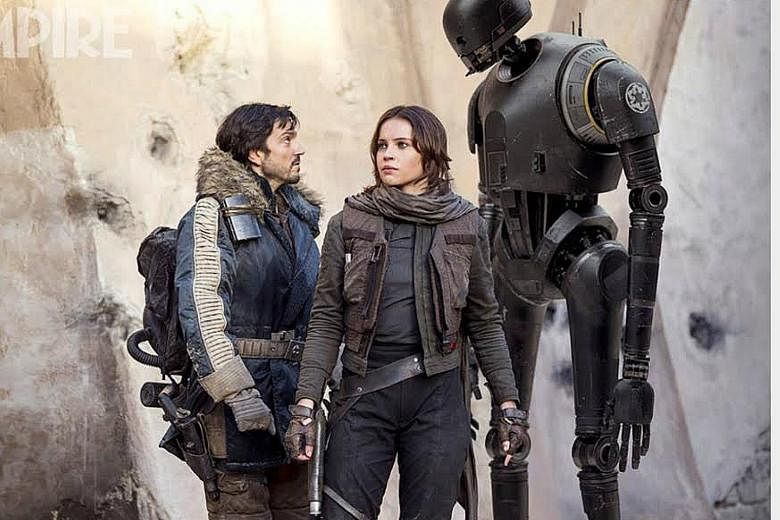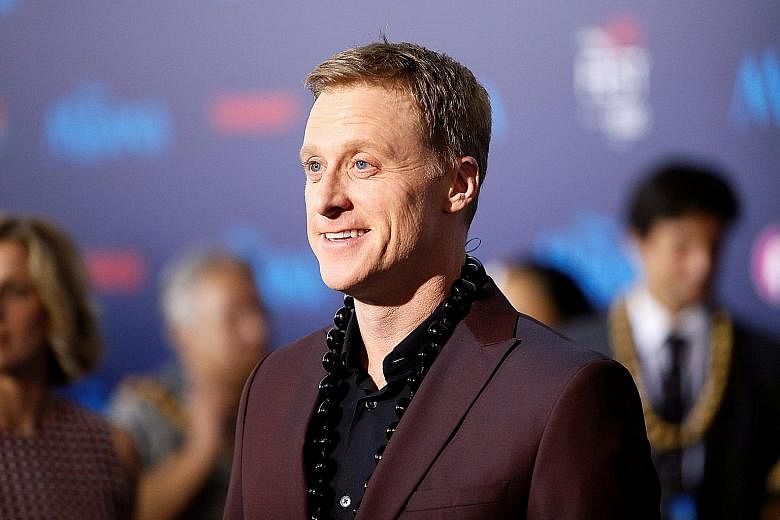NEW YORK • You may not have seen much of actor Alan Tudyk's face, but if you have been watching Disney movies lately, you would have heard a lot of his voice.
He is behind characters in Wreck- It Ralph (2012), Frozen (2013), Big Hero Six (2014), Zootopia (2016) and Moana (2016).
"They like putting me in their movies as a good-luck charm," he said.
Disney's luck is continuing with its latest role for Tudyk: the glowing-eyed reprogrammed droid K-2SO in Rogue One, the first stand-alone Star Wars movie.
The film opened last Friday and Tudyk's character is already a breakout, stealing scenes with his British accent and devil-may-care attitude.
He threw more than his voice into this one: Performing in scenes on location, he donned a motion-capture suit and balanced on stilts to simulate the tall, lanky droid.
In a telephone interview, he spoke of improvising some of K-2SO's lines, running on stilts over sand and the kind of preparation that goes into playing both robots and roosters.
Here are edited excerpts from that conversation.
What happened when you met director Gareth Edwards to talk about Rogue One?
I met him in this nondescript boardroom and he showed me all the secrets to the movie, told me about my character and gave away the ending.
He offered me the role really casually. I initially turned it down.
Excuse me?
I had crowdfunded a show called Con Man and we were in pre-production. We were just about ready to go. I said: "I can do it just as long as it doesn't go in June because I'm not available."
Luckily, Gareth said: "We start in July."
Would you have really skipped out on this role if production started in June?
I had worked so hard to get my show made and we had raised US$3 million (S$4.3 million) weeks before. It was a lot of things at once. There probably would have been a negotiation of people talking sense into me.
The fans who did support the show would have been angered the most if I had turned down K-2.
The role was motion capture and you had done that kind of work before in I, Robot (2004). What was different about it here?
In I Robot, it was about a robot that was having feelings he didn't understand.
The decision was to have him move in a very robotic way. In the world of Star Wars, droids have huge personalities and emotions. So I found if I did any kind of slouching or anything that read as human, it really played well.
We see that in C-3PO too.
Yes, there was a freedom in motion-capturing K-2 because of the history of droids that had come before.
What else helped you build the performance?
I worked with a mask teacher in New York City named Orlando Pabotoy. Mask work is similar to this kind of work - you put a fixed mask on and can't make facial expressions. You have to tell the story through your body.
What was the most challenging aspect?
The stilts were the hardest part. They were 13 inches (33cm) high. I walked around on them for the entire production. Certain things, like sand, were a challenge. Running was scary. You just had to put all your weight forward and hope that nothing goes wrong.
When you took this role, did you think the character might become a breakout?
Gareth said it, but I didn't put any stock in it. We were focused on having a good time.
What did you find most enjoyable?
They let me improv within the role, which was a blast. It was a natural extension of the character.
In the beginning, Cassian, Diego Luna's character, says: "He just says whatever comes into his circuits."
If you're playing a character who says whatever he wants, I felt free to say whatever I wanted on set.
How did the voice come about?
Gareth and I agreed that it made sense he would have an English accent because he was formerly of the Empire and there were so many Imperial characters that have an English accent.
You're playing your fifth Disney animated character in a row in Moana and it's a dumb rooster who speaks in clucks and crows. What was your approach?
It was one of the most fun roles I've done a voice for because when you put that character in extreme circumstances, you are limited to just those sounds. I loved cartoons as a kid and so many funny moments in animation for me are non-verbal sounds, unarticulated mouth noise. This is that to the extreme.
I had a role in Dodgeball (2004), where I played a pirate who played dodge ball. I'd say 80 to 90 per cent of my lines were "garrr" or "arghh". And it was all about what the quality of your "grr-arr" was.
NYTIMES


